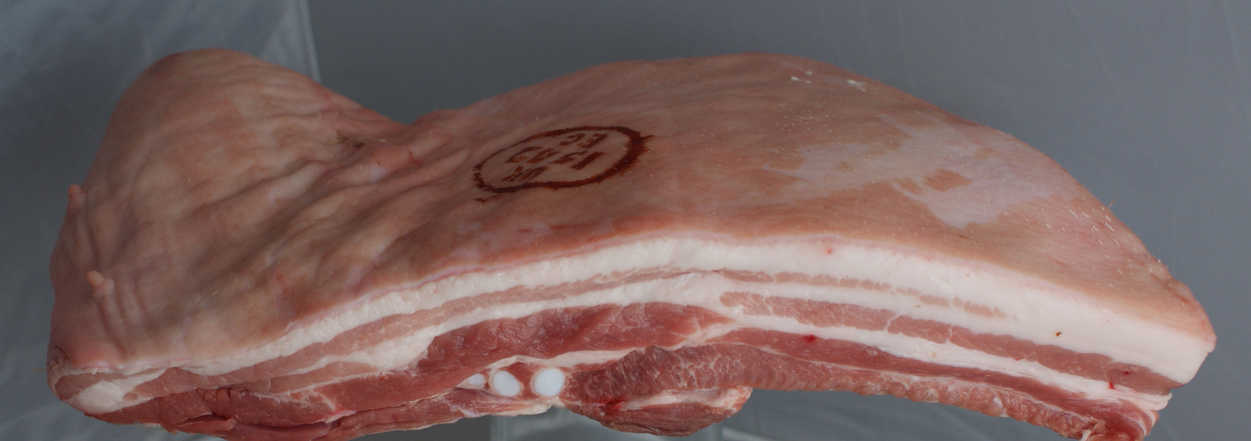
Sausages
Making them. Not cooking them.
Any fool can cook them - not that that doesn't mean a fool can't fuck them up mind you: there's still an art to it.
Any fool can cook them - not that that doesn't mean a fool can't fuck them up mind you: there's still an art to it.
How To Make Sausages
main meat
First Buy Your Sausage Machine
I suppose there are ways of making sausages without mechanical aids, but I'd hate to try it. The sausage machine does the mincing and provides a sort of inverted-funnel feeder to roll the casings onto, like a metre-long condom, so you can just gently massage the sausage out as the thick meaty filling pumps from the machine.
Then here's what you do:
Slaughter Your Sausage Beast
Or find a butcher to sell you the meat and sausage casings.
You'll want a nice tasty meat joint with plenty of fat; 15-20% ideally, or you'll have to add extra fat. Shoulder seems to be a recommended cut with extra fat added, but belly also works and will probably leave you with fat left over.
Natural sausage skins are obviously the best to use, choose a size that will fit over your sausage feeder mine seems to need a diameter of 35mm and make sure you have enough. There's bound to be a lot of casing wastage to start with, I got through over 2m for 1kg of meat.
If you're lucky you can get all this from the same butcher.
Prepare To Grind
Debone your meat and cut into small pieces removing any gristle and sinew or (very) excessive fat along the way. You need chunks that will comfortably feed into your sausage machine (about 1" cubes for mine). Cut up extra fat if required. You can render any spare fat to use for cooking your sausages.
Put the meat and all the removable parts of the sausage machine (except the feeder) into the freezer for a couple of hours to really chill - until it makes your hands hurt to handle it.
Meanwhile cut the casings into manageable lengths (about a metre I'd say) and rinse them in warm water. Flush water through them too (if they're too long at this stage you'll probably end up tying them in fat balloony knots!). Leave to soften in warm water for at least half an hour before using.
Mince or chop your flavour ingredients to the right size, unless you plan on grinding them too.
Sausagebots Assemble!
Put the machine back together with its frozen parts and grind the chilled meat. Mix in any chunky flavourings you'll be using if you want. Season and flavour the mince, trying not to let it get too warm as you mix them in thoroughly - I used a couple of spoons and a large bowl.
Fry samples of the mince to make sure you've got the balance right.
Now remove the cutting blades and perforated disk from the grinder, moisten the feeder and roll a length of casing onto the feeder straight from its bowl of warm water. Leave a few inches hanging from the end.
Start the grinder, push the meat back through and gently but steadily feed the casing out as it fills with mince, moistening the rolled-up skin on the feeder from time to time as necessary to keep it supple.
Do The Twist
Stop the machine once you've only got a few inches of casing left on the feeder as well as you can judge. Remember you'll need enough length to be able to tie it up. Squeeze out any air from either end of your sausage snake and tie knots in both ends (best not to tie up the starting end before filling or you'll just get an air bubble there). Now twist the snake up into sausages - squeeze the end of each link until it's narrow enough to twist, rolling one sausages one way then the next the other way four or five times. Hopefully you didn't fill the skins too firmly or it will be difficult to form links. Don't prick any air bubbles (you don't really want the skins to leak since keeping the juices inside is what effectively cooks the sausage)
Dry the sausages off a bit before packing them away in the fridge - I wrapped mine in muslin and they lasted a week with no obvious ill-effects. Of course you can always freeze them for later.
Eat The Meat
Once you've finally got your sausages made up you might as well treat them with the appropriate respect - cook them long and slowly up to their hips in fat render down any leftover belly pieces to cook them in until they turn beautifully golden and caramelised. Wait until they've started to cook properly before snipping the sausages apart with a pair of scissors. And don't you dare prick them! It might take as long as 20-30 minutes to get them right, but don't rush it.
Enjoy!
There are a number of tricks to learn - some of which I'm still nowhere near mastering:
I suppose there are ways of making sausages without mechanical aids, but I'd hate to try it. The sausage machine does the mincing and provides a sort of inverted-funnel feeder to roll the casings onto, like a metre-long condom, so you can just gently massage the sausage out as the thick meaty filling pumps from the machine.
Then here's what you do:
Slaughter Your Sausage Beast
Or find a butcher to sell you the meat and sausage casings.
You'll want a nice tasty meat joint with plenty of fat; 15-20% ideally, or you'll have to add extra fat. Shoulder seems to be a recommended cut with extra fat added, but belly also works and will probably leave you with fat left over.
Natural sausage skins are obviously the best to use, choose a size that will fit over your sausage feeder mine seems to need a diameter of 35mm and make sure you have enough. There's bound to be a lot of casing wastage to start with, I got through over 2m for 1kg of meat.
If you're lucky you can get all this from the same butcher.
Prepare To Grind
Debone your meat and cut into small pieces removing any gristle and sinew or (very) excessive fat along the way. You need chunks that will comfortably feed into your sausage machine (about 1" cubes for mine). Cut up extra fat if required. You can render any spare fat to use for cooking your sausages.
Put the meat and all the removable parts of the sausage machine (except the feeder) into the freezer for a couple of hours to really chill - until it makes your hands hurt to handle it.
Meanwhile cut the casings into manageable lengths (about a metre I'd say) and rinse them in warm water. Flush water through them too (if they're too long at this stage you'll probably end up tying them in fat balloony knots!). Leave to soften in warm water for at least half an hour before using.
Mince or chop your flavour ingredients to the right size, unless you plan on grinding them too.
Sausagebots Assemble!
Put the machine back together with its frozen parts and grind the chilled meat. Mix in any chunky flavourings you'll be using if you want. Season and flavour the mince, trying not to let it get too warm as you mix them in thoroughly - I used a couple of spoons and a large bowl.
Fry samples of the mince to make sure you've got the balance right.
Now remove the cutting blades and perforated disk from the grinder, moisten the feeder and roll a length of casing onto the feeder straight from its bowl of warm water. Leave a few inches hanging from the end.
Start the grinder, push the meat back through and gently but steadily feed the casing out as it fills with mince, moistening the rolled-up skin on the feeder from time to time as necessary to keep it supple.
Do The Twist
Stop the machine once you've only got a few inches of casing left on the feeder as well as you can judge. Remember you'll need enough length to be able to tie it up. Squeeze out any air from either end of your sausage snake and tie knots in both ends (best not to tie up the starting end before filling or you'll just get an air bubble there). Now twist the snake up into sausages - squeeze the end of each link until it's narrow enough to twist, rolling one sausages one way then the next the other way four or five times. Hopefully you didn't fill the skins too firmly or it will be difficult to form links. Don't prick any air bubbles (you don't really want the skins to leak since keeping the juices inside is what effectively cooks the sausage)
Dry the sausages off a bit before packing them away in the fridge - I wrapped mine in muslin and they lasted a week with no obvious ill-effects. Of course you can always freeze them for later.
Eat The Meat
Once you've finally got your sausages made up you might as well treat them with the appropriate respect - cook them long and slowly up to their hips in fat render down any leftover belly pieces to cook them in until they turn beautifully golden and caramelised. Wait until they've started to cook properly before snipping the sausages apart with a pair of scissors. And don't you dare prick them! It might take as long as 20-30 minutes to get them right, but don't rush it.
Enjoy!
There are a number of tricks to learn - some of which I'm still nowhere near mastering:
- Firstly getting the casings on to the feeder is a nightmare, that requires rolling it up from a pot of warm water which keeps the casing supple. Rinse and soak the casings in warm water for a good half hour before you need to use them.
- Work with managable lengths of casing at a time or you'll never get the whole thing loaded onto the feeder.
- Don't try and use a casing narrower than your feeder or you'll never get it on - my butcher sold me a casing he describe as standard sized (he also referred to it as size 264 but he may have made that up), and it was about the thinnest I could imagine working with on my machine.
- Once the casing is rolled onto the feeder, don't let it dry out - so you need to use it quite quickly, and keep moistening it with warm water as you work to keep the casing supple and elastic.
- Chill everything thoroughly before grinding or feeding. This means the meat and the machine parts. This will make the mincing action much cleaner and reduce the amount clogging from soft fat and prevent mushing up the meat. You can leave the cut meat in the freezer for at least a couple of hours so it is well chilled.
- I don't know whether it's me, or the machine, or my technique,
but filling the casings while grinding the meat resulted in a very over-ground filling.
This might be solved by speeding up my feeding process, or, as I did, by mincing the meat through first,
then taking out the cutter blades and disk and just running the mince back through straight into the casings.
It makes it very much more difficult to control the rate of fill, but at least the filling isn't puréed.
Plus this allows you to thoroughly mix the additional ingredients into the mince before filling the skins. - If you underfill the casing then obviously your sausages will be limp and there'll be lots of empty sock to deal with.
- On the other hand if you overfill then there'll be regular splitting, which gets messy and irritating, and you won't have room left to twist the links in.
- It seems there's always going to be a lot of wastage, either from the filling which squidges out through the splits, or the last wedge of mince which remains in the guts of the machine. So plan on also making some burgers.
Ingredients:
Pork Sausages with Sundried Tomato and Basil
main meat
Makes about a dozen links or soIngredients
- 1kg skinned, deboned pork belly with any (very) excessive fat removed
- 12 sun-dried (half?) tomato pieces in olive oil
- 1 tablespoon tomato purée They were more impressive when I made them with treble the amount.
- handful basil leaves
- 1-2 teaspoons salt
Skin, debone and trim the belly pork of excess fat.
Be sure to cut away any tomato stalk or other tough parts. Stir into the ground meat before feeding the sausages.
Be sure to cut away any tomato stalk or other tough parts. Stir into the ground meat before feeding the sausages.
Not quite tomato-y enough for my tastes, so I'd suggest adding more paste than I did.
Still pretty good though.
Pork Sausages with Sundried Tomato, Feta and Rosemary
main meat
I made around 20 linksIngredients
- 3lb (1.5kg) pork shoulder and belly fat
- 1 x 80g tube sundried tomato paste (3-4 tablespoons?)
- 6-12 sundried tomatoes in olive oil
- 100g (a half block)of feta finely chopped
- a few sprigs of rosemary, leaves only. About 3 teaspoons when roughly ground.
- 1-2 teaspoons salt.
- port optional - and I forgot it. Not sure it would have gone with the feta?
Make sure you've got enough belly fat to give you a decent mix of fat in the shoulder.
Grind your rosemary until it's quite fine (I didn't fancy having tough shards in there),
chop the tomatoes into decent 1cm pieces and break up the feta to about the same sized cubes.
Mix the seasonings into the mince, finally incorporating the feta quite carefully so as not to completely mash it up.
Mix the seasonings into the mince, finally incorporating the feta quite carefully so as not to completely mash it up.
Really tasty actually.
I had originally thought of adding some port too, but you know I'm not sure it would have worked.
A herb liqueur like Kümmel might be quite nice though.
Wild Boar Sausages with Maple Syrup
main meat
My butcher happened to have some wild boar belly for a pretty reasonable price too.
So I snatched it up.
I made these sausages using a wider skin than previously which worked just fine - they render down quite a bit anyway.
So I snatched it up.
I made these sausages using a wider skin than previously which worked just fine - they render down quite a bit anyway.
I made about 18 fat links
Ingredients
- 2kg (4lb) boar belly
- 3-4 teaspoons ancho chilli powder (or pimento dulce)
- 1-2 teaspoons salt
- 3-4 tablespoons maple syrup (don't overdo it - it's quite strong and cloying)
Just dribble the spices and syrup over the minced boar and combine thoroughly.
Do this in at least two stages, frying and tasting as you go so as not to add too much.
Surprisingly fantastic!
Who would have thought that maple syrup would work so well? As long as you don't go completely nuts anyway. The paprika or mild chilli powder adds a nice background kick. Don't overdo that either :)
Who would have thought that maple syrup would work so well? As long as you don't go completely nuts anyway. The paprika or mild chilli powder adds a nice background kick. Don't overdo that either :)
Inspired by a very tasty
stuffed saddle of lamb
Lamb Sausages with Oysters, Lemon and Watercress
main meat
OK so I havent tried this yet, but I definitely fancy giving it a go - the combination worked pretty well in a
rolled roast joint.
I think you'd need a nice redcurrant jelly, port and mustard gravy to go with.
Ingredients
- lamb
- anchovies
- oysters
- lemon
- watercress
- allspice/nutmeg
Christmas Sausage
main meat
I wanted to make some sausages that evoked the season - Christmas trees and Christmas puddings.
I remembered having a tasty little schnapps whilst skiing in Austria that was very pine resin. Though the hotel owner claimed to make the stuff himself I found something online that sounded pretty close - a slim bottle of Zirbenz Stone Pine Liqueur, also from the Austrian alps.
When you peel away the duck skin you'll find it more-or-less impossible to separate a useful amount of fat, so add back about 20% pork belly fat.
I also used a couple of duck breasts to try out some sage and shallot flavoured sausages as a fallback, mincing a shallot and about a dozen sage leaves and adding them to the ground duck breasts. They were perfectly acceptable, but I preferred the Zirbenz and cranberry versions below. I considered chestnuts as another Christmassy possibility, but didn't get around to following that up. Maybe another year?
Incidentally it's quite wasteful grinding small quantities of meat, given how much mince gets lost in the parts of the machine, so now you have the perfect excuse to multiply up the quantities below and blow all your Christmas bonus on the ducks!
I served these up as a Christmas starter with quenelles de pommes dauphine and red onion marmalade, and they were very well received. Although I couldn't really say that once cooked they were even vaguely reminiscent of Christmas trees.
Pity.
I remembered having a tasty little schnapps whilst skiing in Austria that was very pine resin. Though the hotel owner claimed to make the stuff himself I found something online that sounded pretty close - a slim bottle of Zirbenz Stone Pine Liqueur, also from the Austrian alps.
There's also this French possibility; Un Sapin
(Pernod produce a version),
and I did wonder if Indian screw pine essence (Pandan/Kewra/Kewda water) would have the same flavour?
I believe you can get Scots Pine essential oil (for aromatherapists, but I'm sure they wouldn't mind me eating some).
I even heard about a Polish pine liquor made by packing young pinecones in sugar and collecting the extracted syrup. I'll need to wait for the spring to try that out though...
Duck seemed the ideal meat choice for these - close enough to turkey without being goose.
I had heard that you could chop up the duck's skin and fat into the sausage instead of adding additional pork fat,
so I tried that out on a small batch. Although it does work, the resulting sausages taste fine but are a little bit too dense
- I'd stick with the pork.I believe you can get Scots Pine essential oil (for aromatherapists, but I'm sure they wouldn't mind me eating some).
I even heard about a Polish pine liquor made by packing young pinecones in sugar and collecting the extracted syrup. I'll need to wait for the spring to try that out though...
When you peel away the duck skin you'll find it more-or-less impossible to separate a useful amount of fat, so add back about 20% pork belly fat.
I also used a couple of duck breasts to try out some sage and shallot flavoured sausages as a fallback, mincing a shallot and about a dozen sage leaves and adding them to the ground duck breasts. They were perfectly acceptable, but I preferred the Zirbenz and cranberry versions below. I considered chestnuts as another Christmassy possibility, but didn't get around to following that up. Maybe another year?
Incidentally it's quite wasteful grinding small quantities of meat, given how much mince gets lost in the parts of the machine, so now you have the perfect excuse to multiply up the quantities below and blow all your Christmas bonus on the ducks!
I served these up as a Christmas starter with quenelles de pommes dauphine and red onion marmalade, and they were very well received. Although I couldn't really say that once cooked they were even vaguely reminiscent of Christmas trees.
Pity.
Makes half a dozen or so small sausages.
Ingredients
- 2 plump duck breasts (400g/12 oz), skin removed
- a chunk of pork fat (80g/3-4 oz)
- 1 tablespoon roughly chopped sweetened, dried cranberries
- 1 tablespoon + 1 teaspoon Zirbenz
- ½ teaspoon salt
- grinding of pepper
Remove the skin (probably all the fat will come off too), cut the breasts into chunks and chill thoroughly
along with the machine parts.
You will need 15-20% fat, so cut up a chunk of pork fat too.
Grind the duck and fat.
Use those packets of sweetened, dried cranberries, and roughly chop, or maybe halve, them - you don't want them too small, they should be noticeable in the finished sausage.
Mix the mince with the cranberries, seasoning, and as much pine liqueur as it will take.
Let the sausages dry by hanging them or wrapping them in muslin to drain before storing them in the fridge.
You will need 15-20% fat, so cut up a chunk of pork fat too.
Grind the duck and fat.
Use those packets of sweetened, dried cranberries, and roughly chop, or maybe halve, them - you don't want them too small, they should be noticeable in the finished sausage.
Mix the mince with the cranberries, seasoning, and as much pine liqueur as it will take.
I made a batch by soaking whole dried cranberries in Zirbenz for a couple of days before using them,
but I'm not sure it made much difference to the flavour. The cranberries get a bit soggy too.
I quite like them to have a bit of bite.
Stuff into the thinnest skins you can feed onto your machine.
Make fairly short sausages, so don't overfill the casings - we're looking for delicate chipolatas here,
not hoofing great Cumberlands.Let the sausages dry by hanging them or wrapping them in muslin to drain before storing them in the fridge.
Although the distinctive pine of the Zirbenz pretty much disappears during cooking, they're still really good.
Maybe try with a more intense pine resin flavour - if you can find one?
Maybe try with a more intense pine resin flavour - if you can find one?
Venison Sausages with Sage and Juniper
main meat
Makes 5lb - about 20 linksIngredients
- 4lb (2kg) venison
- 1lb (500g) pork fat
- 1 tablespoon (15g) juniper berries, ground
- 2 tablespoons (25g) fresh sage, chopped
- 1 tablesppon ground black pepper
- ¼ cup gin
- 1-2 teaspoons salt
Well, you know what to do by now - grind up the meat, mix everything together, stuff it into sausage skins.
Made these for a West Coast yacht charter.
Pretty reasonable, if a bit more of a gamey challenge than the others.
Black Pudding
meat breakfast main
I've fancied having a go at black pudding ever since I started making sausages;
it seemed like the ultimate filling.
Well, it was certainly fun to try, but I won't be doing it again.
My entire flat looks like a slaughterhouse, from the bathroom where I kept and strained out my bucket of blood on ice, to the kitchen where gouts of blood squirted up the walls from driving the pudding mixture through my sausage machine. Which leaked blood all over the floor, and into its own guts so I had to strip it apart to clean it all out afterwards. The cleanup was immense.
The whole effort took a day and a half, I suppose if you had a barn to work in and a wet-work area that you could simply hose down afterwards this might be worth another go, but I think I've seen all I need to!
Despite my initial concerns, the blood kept perfectly well sitting on ice for several days without coagulating. Which is handy - as I had to drive it around in the boot of my car for a day while I went to work. My butcher assures me he can store gallons of blood near zero degrees for five days without problems.
I used a large natural hog casing which my butcher referred to as runners. When filled it has a diameter of about 2".
Having read other people's experiences making naturally-cased puddings, I was extremely cautious about not over-boiling them to limit splitting. As a result my puddings were not as dark, well-cooked, nor dense as a butchers. Though some of that may have to do with the butcher being able to pack his mixture much more firmly into plastic sleeves than intestines. I think mine tasted just as good for all that; maybe better, and it's nice to be able to eat the crispy skin too, but they certainly don't last as long.
My butcher tells me they drop theirs into a large pot of boiling water, turn off the heat until the puddings have set then gently bring them back to simmer again. I quite liked my bain-marie approach for controllability, but if I were paid enough to do this again I'd definitely cook them hotter and for longer before considering them done.
I based my filling proportions on some of the many variations out there. Given the volume of blood I had available I decided to try a couple of novelty flavours in addition to regular. I really thought my chocolate pudding was genius, the apple was quite acceptable too, though it seemed to markedly extend the pudding cooking time. Go figure.
They certainly made for a fun dinner party course!
Incidentally, if you want to skip the whole messy, complicated, balloon-filling you can just pour the mixture into small loaf tins and bake at 180°C/350°F/Gas Mark 4 for an hour or until cooked. This works very effectively. You can cut these black pudding loaves into manageable sections and freeze them too. Just defrost, slice, then fry as normal.
My entire flat looks like a slaughterhouse, from the bathroom where I kept and strained out my bucket of blood on ice, to the kitchen where gouts of blood squirted up the walls from driving the pudding mixture through my sausage machine. Which leaked blood all over the floor, and into its own guts so I had to strip it apart to clean it all out afterwards. The cleanup was immense.
The whole effort took a day and a half, I suppose if you had a barn to work in and a wet-work area that you could simply hose down afterwards this might be worth another go, but I think I've seen all I need to!
Despite my initial concerns, the blood kept perfectly well sitting on ice for several days without coagulating. Which is handy - as I had to drive it around in the boot of my car for a day while I went to work. My butcher assures me he can store gallons of blood near zero degrees for five days without problems.
I used a large natural hog casing which my butcher referred to as runners. When filled it has a diameter of about 2".
Having read other people's experiences making naturally-cased puddings, I was extremely cautious about not over-boiling them to limit splitting. As a result my puddings were not as dark, well-cooked, nor dense as a butchers. Though some of that may have to do with the butcher being able to pack his mixture much more firmly into plastic sleeves than intestines. I think mine tasted just as good for all that; maybe better, and it's nice to be able to eat the crispy skin too, but they certainly don't last as long.
My butcher tells me they drop theirs into a large pot of boiling water, turn off the heat until the puddings have set then gently bring them back to simmer again. I quite liked my bain-marie approach for controllability, but if I were paid enough to do this again I'd definitely cook them hotter and for longer before considering them done.
I based my filling proportions on some of the many variations out there. Given the volume of blood I had available I decided to try a couple of novelty flavours in addition to regular. I really thought my chocolate pudding was genius, the apple was quite acceptable too, though it seemed to markedly extend the pudding cooking time. Go figure.
They certainly made for a fun dinner party course!
Incidentally, if you want to skip the whole messy, complicated, balloon-filling you can just pour the mixture into small loaf tins and bake at 180°C/350°F/Gas Mark 4 for an hour or until cooked. This works very effectively. You can cut these black pudding loaves into manageable sections and freeze them too. Just defrost, slice, then fry as normal.
Makes pounds and pounds of pudding
Ingredients
Plain Pudding:- 1 litre blood
- 2m casing
- 300g onion
- 375g pork fat
- 300g fine oatmeal
- 1 shot-glass cognac
- 2 teaspoons mixed peppercorns
- 1 teaspoon (3 pieces) whole mace
- 1 teaspoon allspice
- 1 teaspoon ground coriander
- ½ teaspoon dried mint
- 2 teaspoons salt
Chocolate Pudding:- 1 litre blood
- 2m casing
- 300g onion
- 350g pork fat
- 250g pearl barley (cooked weight)
- 100g fine oatmeal
- glass red wine
- 2 teaspoons mixed peppercorns
- 1 teaspoon (3 pieces) whole mace or ½ tsp ground mace
- 1 teaspoon allspice
- 2 teaspoon ground paprika
- 25g grated chocolate
- 4 tsp salt
Apple Pudding:- 1 litre blood
- 2m casing
- 300g onion
- 375g pork fat
- 300g fine oatmeal
- 2 Granny Smith apples
- 1 shot-glass apple liqueur
- 1 shot-glass Calvados
- 2 teaspoons mixed peppercorns
- 1 teaspoon (3 pieces) whole mace or ½ tsp ground mace
- ½ teaspoon grated nutmeg
- 1 teaspoon allspice
- 2 teaspoon fennel seeds
- 1 teaspoon dried mint
- 4 teaspoons salt
First buy your blood :)
Keep it on ice, or in a really cold refrigerator, until required.
Thoroughly wash the sausage casings in changes of fresh water, making sure to run some inside them too. I find it convenient to cut them into 60cm lengths - or whatever your sausage filler will handle. Keep them in warm water until needed.
Weigh out and prepare all your ingredients; grinding the seeds to powder, roughly crushing the herbs, boiling the barley (use a small amount of stock for this), mincing the onions, grating the chocolate as appropriate.
Peel, core and dice the apple into 1cm cubes if using.
Remove any skin from your fatty belly pork and cut into 1cm cubes (or to taste). I did try mincing the fat in my sausage machine, but the effect isn't as good Gently fry the cubed fat until it starts to render, keeping it moving. Remove with a slotted spoon and set aside.
In the fat remaining in the pan, sweat the onion until it becomes glassy but has not coloured.
Carefully strain out each quantity of blood to remove any clots (I used a hairnet - damn useful, hairnets).
In a large bowl, using your hands, mix in about half of all the measured ingredients into the blood. Now add the remaining fat, barley and oatmeal to achieve the right consistency - you're looking for something like sloppy porridge - the uncooked oatmeal will swell as it absorbs blood so don't add too much too quickly.
Now adjust the flavour by frying up small tastes of the mixture while gradually adding the remaining seasonings to taste.
When you're happy with the mixture prepare the casings for stuffing: roll a length onto your sausage machine horn, or a funnel. Tie a knot firmly in the end. Pour the mixture into the machine or funnel and using a pestle to force the mixture through and a little massaging of the filling casing, extrude lengths of sausage, tying knots tightly at intervals.
Adjust your oven to hold a bain-marie at 80°C. Carefully lower in the strangely attractive wobbly crimson puddings and cook for 1 hour. My oven needed to be about Gas Mark 4 (350°F) to hold their temperature during cooking. When done, the centre of the puddings should be at least 70°C and when pricked will leak brown liquid, or preferably nothing at all, and definitely not blood.
Drain the puddings, and dry them with paper towels or muslin. Grease them thoroughly with lard by hand when they are cool enough to handle. They should keep this way for weeks, even in the pantry, if you've cooked them well enough. If they start leaking blood, then you didn't.
To serve, cut into thick slices and fry gently in a generous amount of fat until crispy on the outside, or you can also roast them whole at Gas Mark 4-5 for 40-60 minutes in a well-greased roasting tin (though this tends to toughen the skin).
Keep it on ice, or in a really cold refrigerator, until required.
Thoroughly wash the sausage casings in changes of fresh water, making sure to run some inside them too. I find it convenient to cut them into 60cm lengths - or whatever your sausage filler will handle. Keep them in warm water until needed.
Weigh out and prepare all your ingredients; grinding the seeds to powder, roughly crushing the herbs, boiling the barley (use a small amount of stock for this), mincing the onions, grating the chocolate as appropriate.
Peel, core and dice the apple into 1cm cubes if using.
Remove any skin from your fatty belly pork and cut into 1cm cubes (or to taste). I did try mincing the fat in my sausage machine, but the effect isn't as good Gently fry the cubed fat until it starts to render, keeping it moving. Remove with a slotted spoon and set aside.
In the fat remaining in the pan, sweat the onion until it becomes glassy but has not coloured.
Carefully strain out each quantity of blood to remove any clots (I used a hairnet - damn useful, hairnets).
In a large bowl, using your hands, mix in about half of all the measured ingredients into the blood. Now add the remaining fat, barley and oatmeal to achieve the right consistency - you're looking for something like sloppy porridge - the uncooked oatmeal will swell as it absorbs blood so don't add too much too quickly.
Now adjust the flavour by frying up small tastes of the mixture while gradually adding the remaining seasonings to taste.
When you're happy with the mixture prepare the casings for stuffing: roll a length onto your sausage machine horn, or a funnel. Tie a knot firmly in the end. Pour the mixture into the machine or funnel and using a pestle to force the mixture through and a little massaging of the filling casing, extrude lengths of sausage, tying knots tightly at intervals.
It's essential there are no air-pockets in the puddings as you fill them or they will swell and split when boiled.
Given the liquidity of the stuffing this isn't usually much of a problem.
Unlike sausages you can't just twist in the links - these will leak everywhere given the slightest chance,
so they need good knots.
Put a bowl under the machine horn and allow the sausages to fall in there as you cut the skins apart ready to cook.
These thick skins are quite sturdy as it turns out.Adjust your oven to hold a bain-marie at 80°C. Carefully lower in the strangely attractive wobbly crimson puddings and cook for 1 hour. My oven needed to be about Gas Mark 4 (350°F) to hold their temperature during cooking. When done, the centre of the puddings should be at least 70°C and when pricked will leak brown liquid, or preferably nothing at all, and definitely not blood.
Despite this being the recommended temperature - I found that if you want to turn all traces of blood to the socially acceptable solid blackness,
then you need at least 85°C (especially for some reason, with the apple flavoured sausage).
I should probably have increased the heat up to 90°C once the sausages had stabilised and no longer in danger of splitting.
It makes no difference if you're not keeping them too long, but if you want to give them to friends as presents, say because you've had to buy 5 litres of blood and you now have enough slightly undercooked bloody pudding to feed the British Army, even after their recent cuts efficiency savings, then you should probably microwave them until they are completely black when you cut them open.
I read many online suggestions that you should prick your puddings, particularly if they float to the surface of the simmering liquid. My butcher, on the other hand, is quite emphatic that you most definitely should not.
I was fortunate not to have the need.
It makes no difference if you're not keeping them too long, but if you want to give them to friends as presents, say because you've had to buy 5 litres of blood and you now have enough slightly undercooked bloody pudding to feed the British Army, even after their recent cuts efficiency savings, then you should probably microwave them until they are completely black when you cut them open.
I read many online suggestions that you should prick your puddings, particularly if they float to the surface of the simmering liquid. My butcher, on the other hand, is quite emphatic that you most definitely should not.
I was fortunate not to have the need.
Drain the puddings, and dry them with paper towels or muslin. Grease them thoroughly with lard by hand when they are cool enough to handle. They should keep this way for weeks, even in the pantry, if you've cooked them well enough. If they start leaking blood, then you didn't.
To serve, cut into thick slices and fry gently in a generous amount of fat until crispy on the outside, or you can also roast them whole at Gas Mark 4-5 for 40-60 minutes in a well-greased roasting tin (though this tends to toughen the skin).
Really excellent - better than shop-bought. Looser, less mealy, and with a better flavour.
Plus for bonus points you can eat the skin.
I particularly liked my chocolate invention - just a hint of bitter richness with some paprika sharpness. You could use chilli powder if you preferred.
I particularly liked my chocolate invention - just a hint of bitter richness with some paprika sharpness. You could use chilli powder if you preferred.
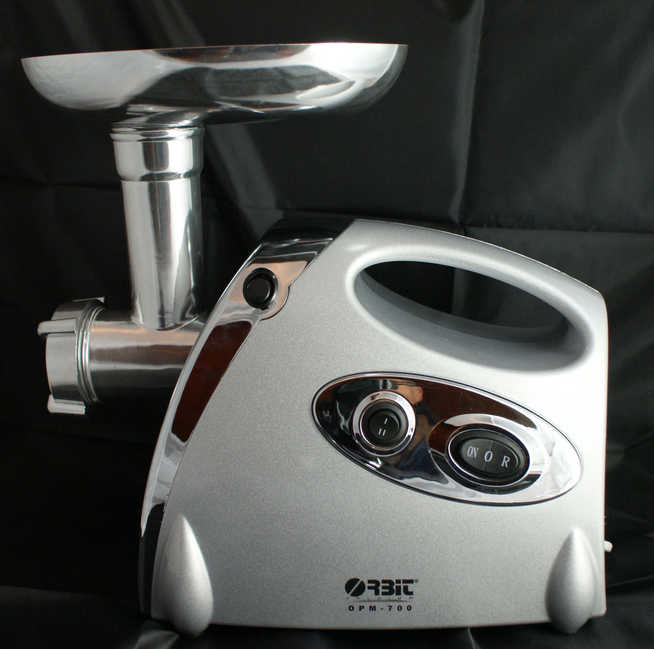
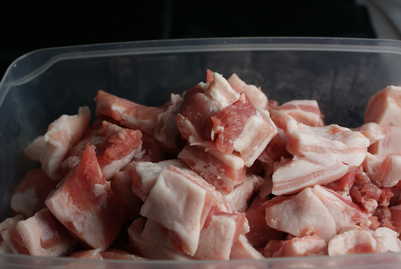
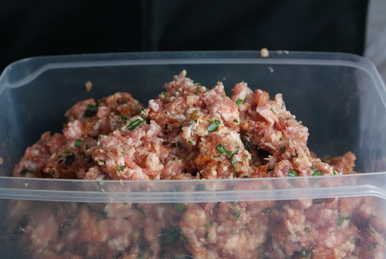
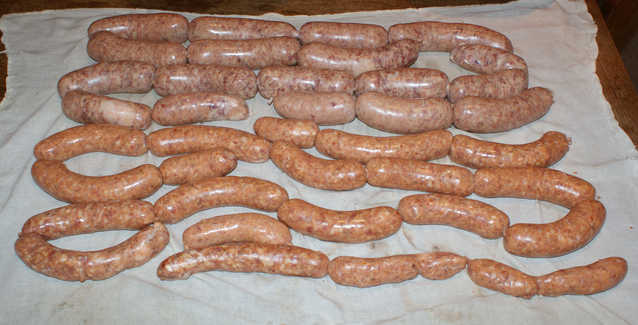
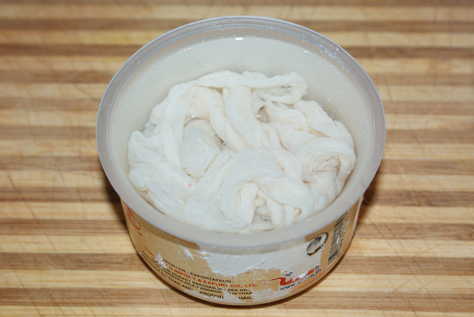
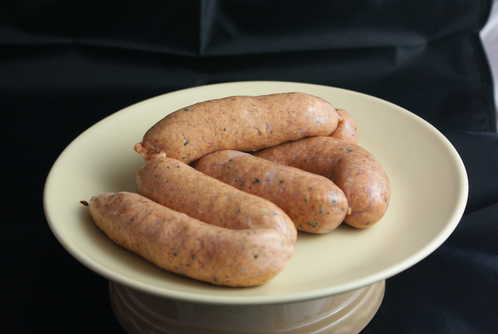
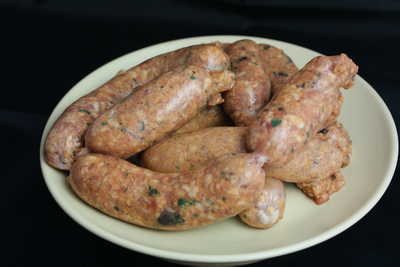


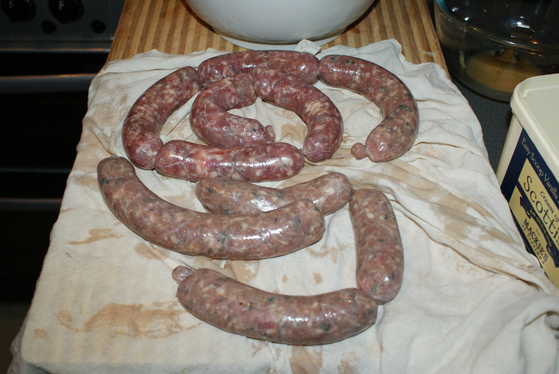
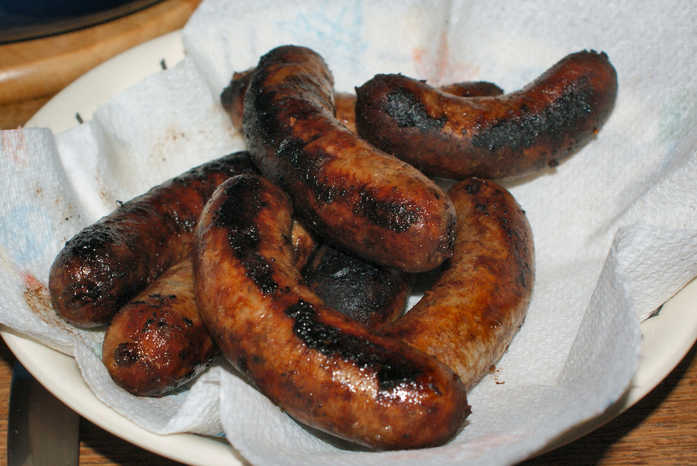
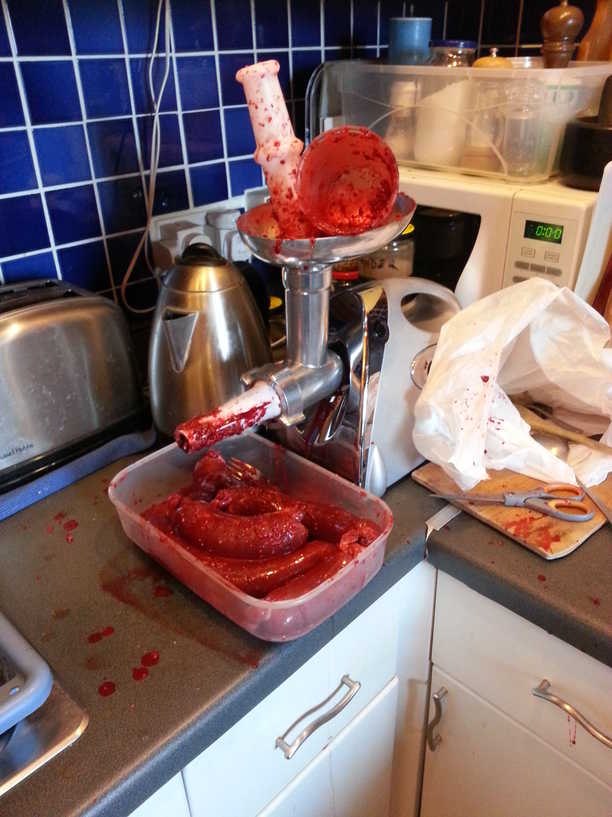

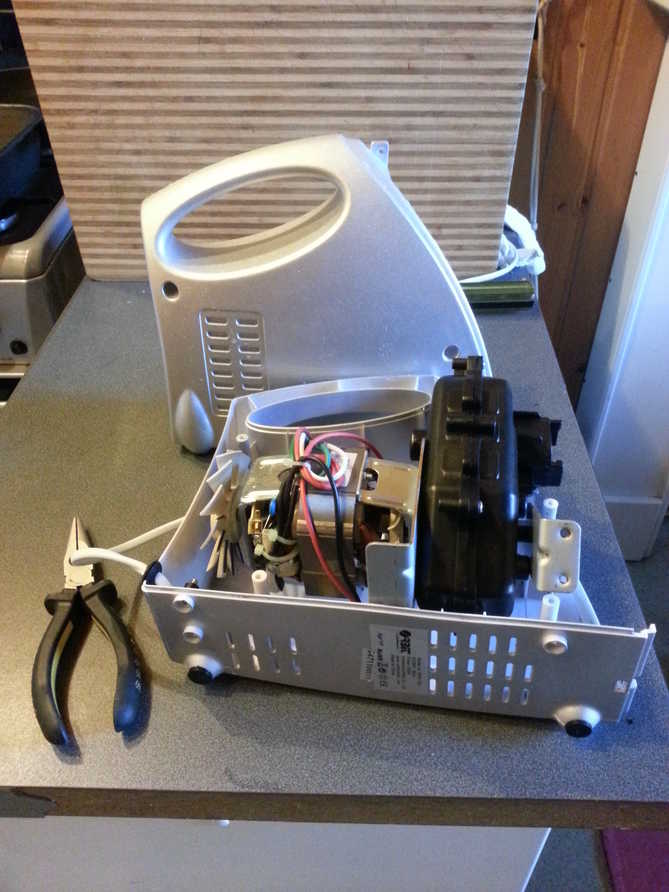
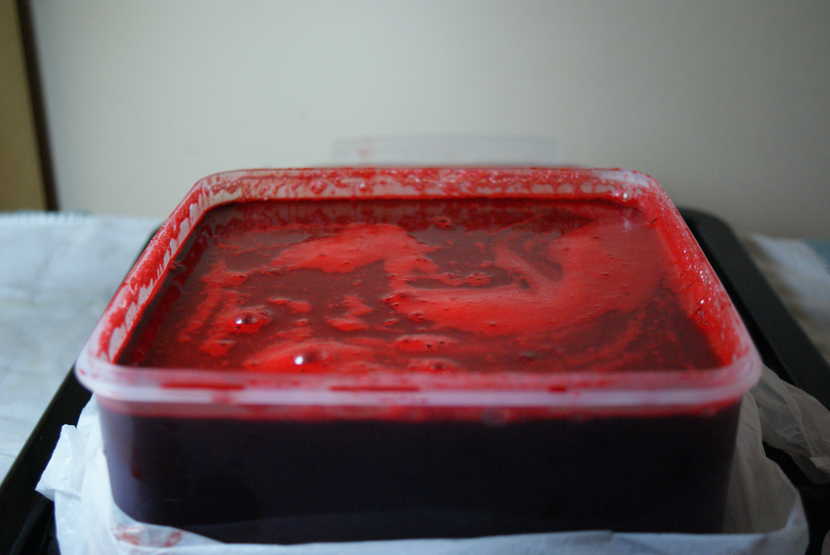

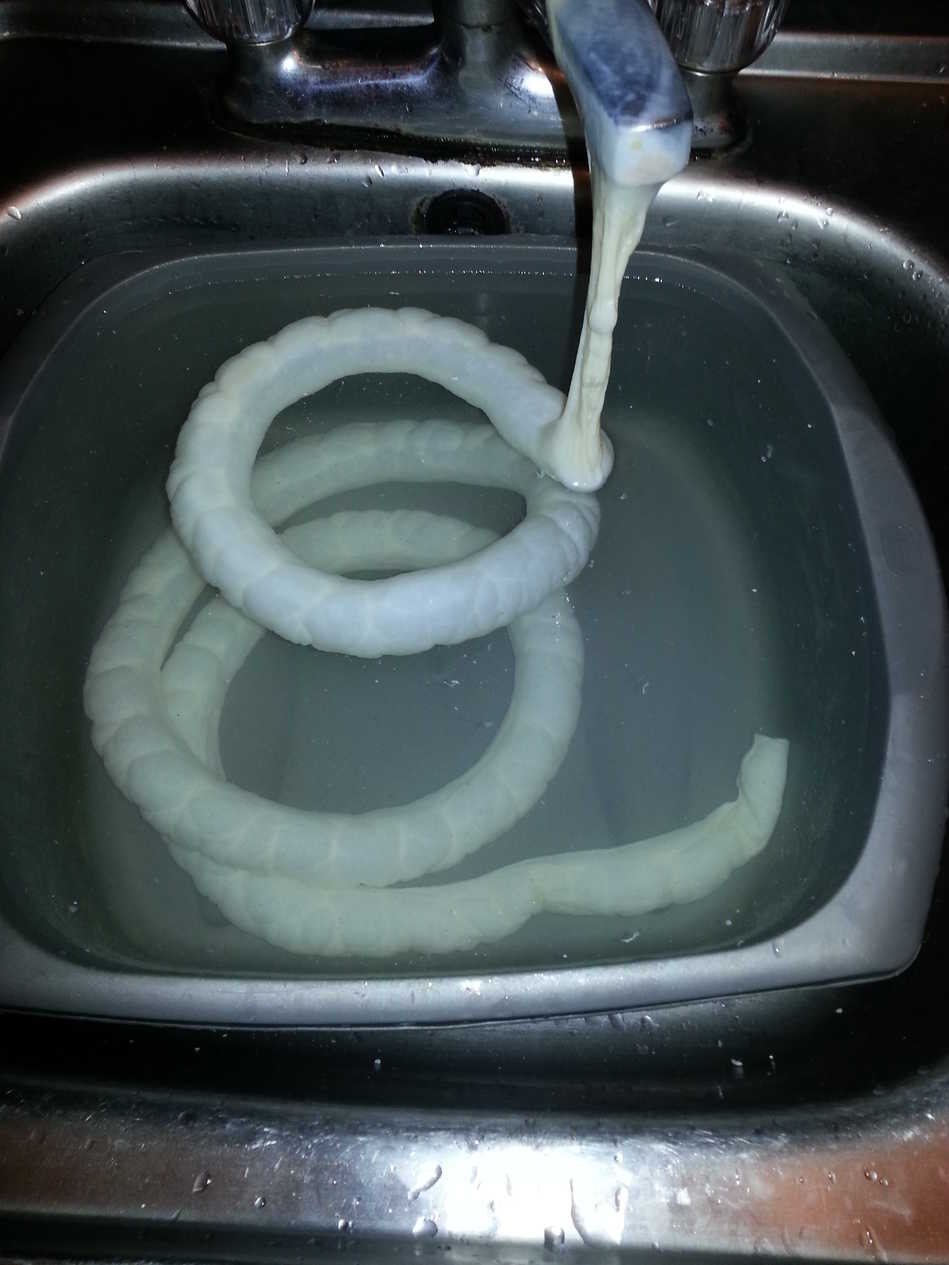
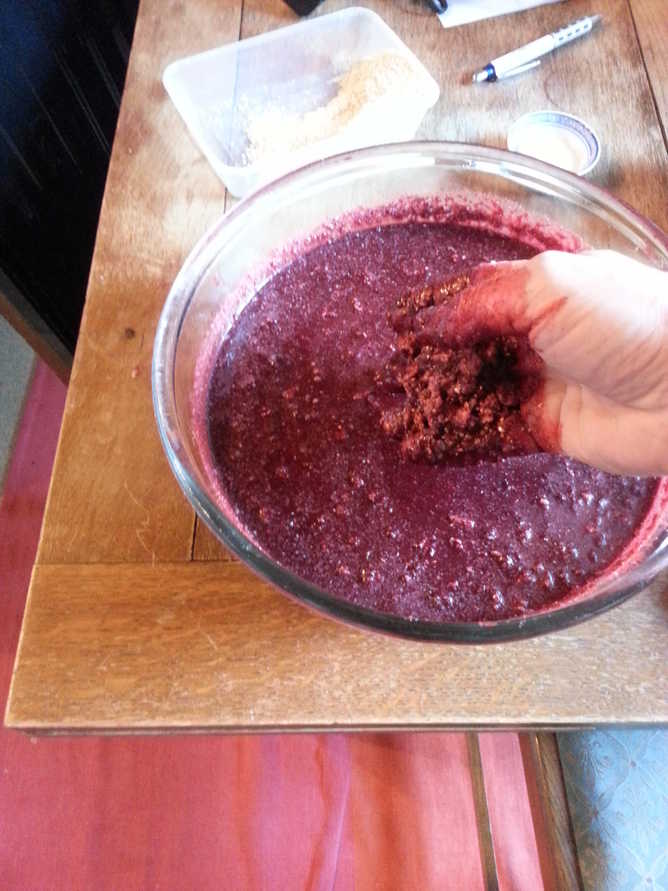
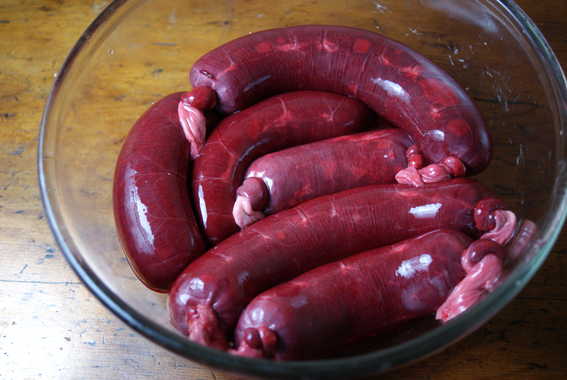
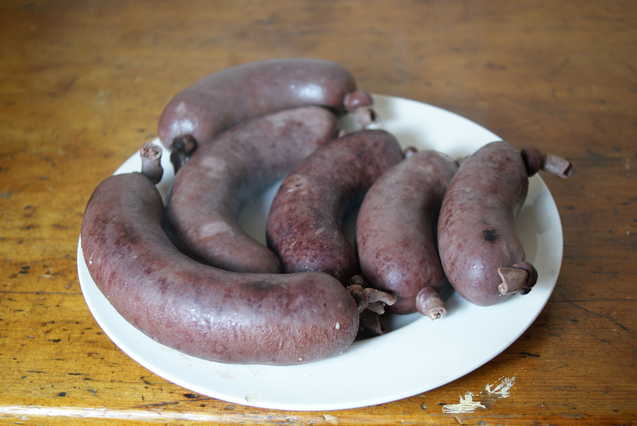
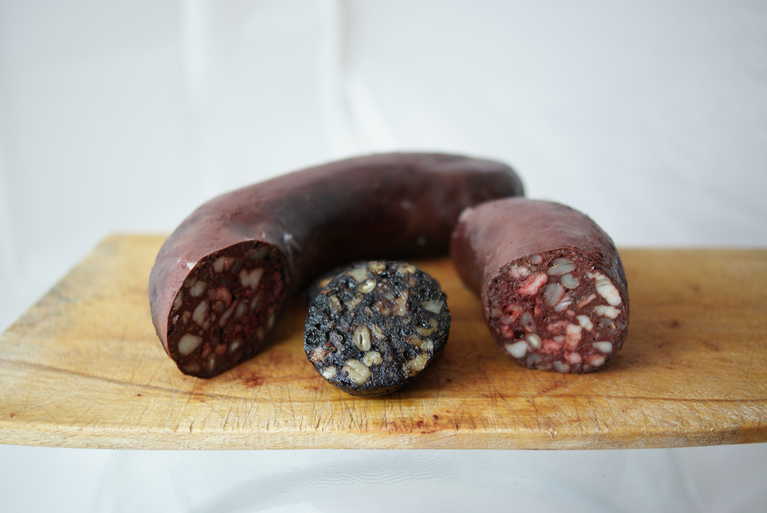
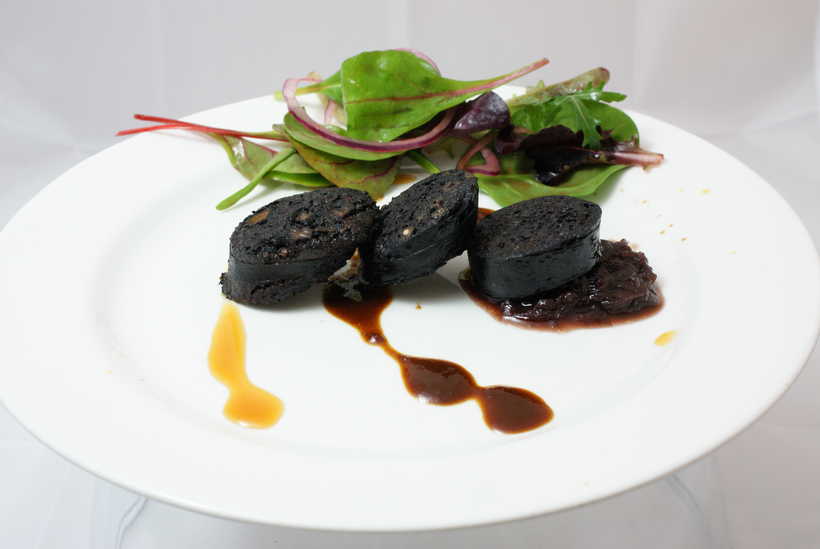
I removed what looked like absolutely excessive fat, but the cooked sausage meat seemed a little dry, so perhaps I was over-enthusiastic?